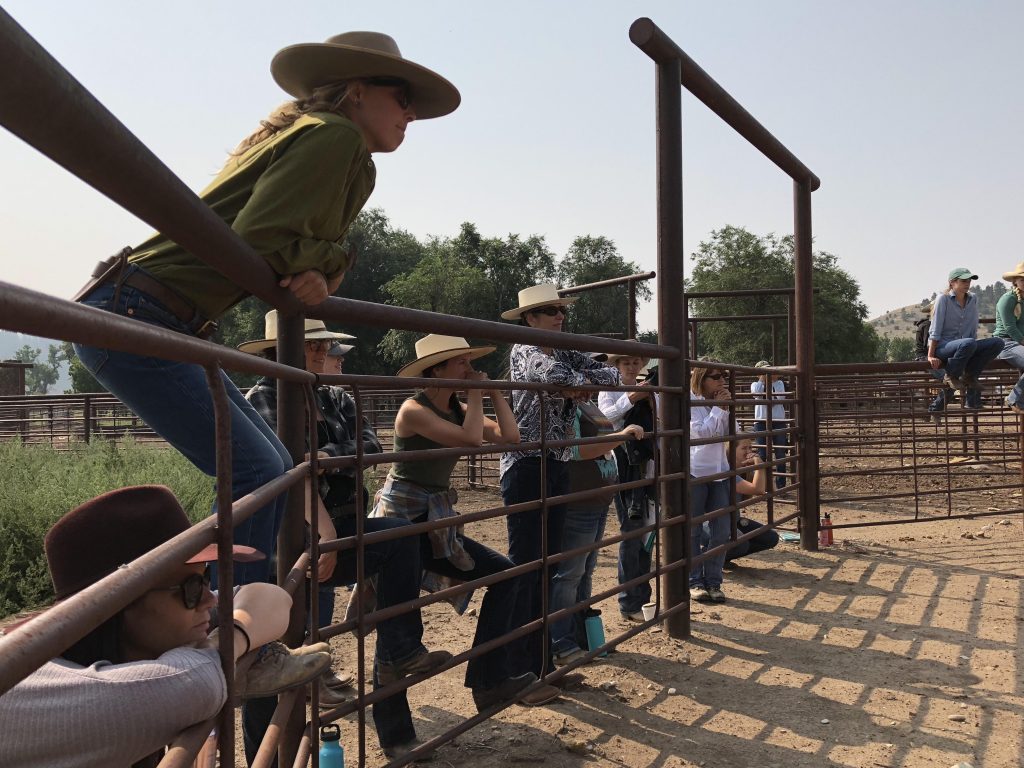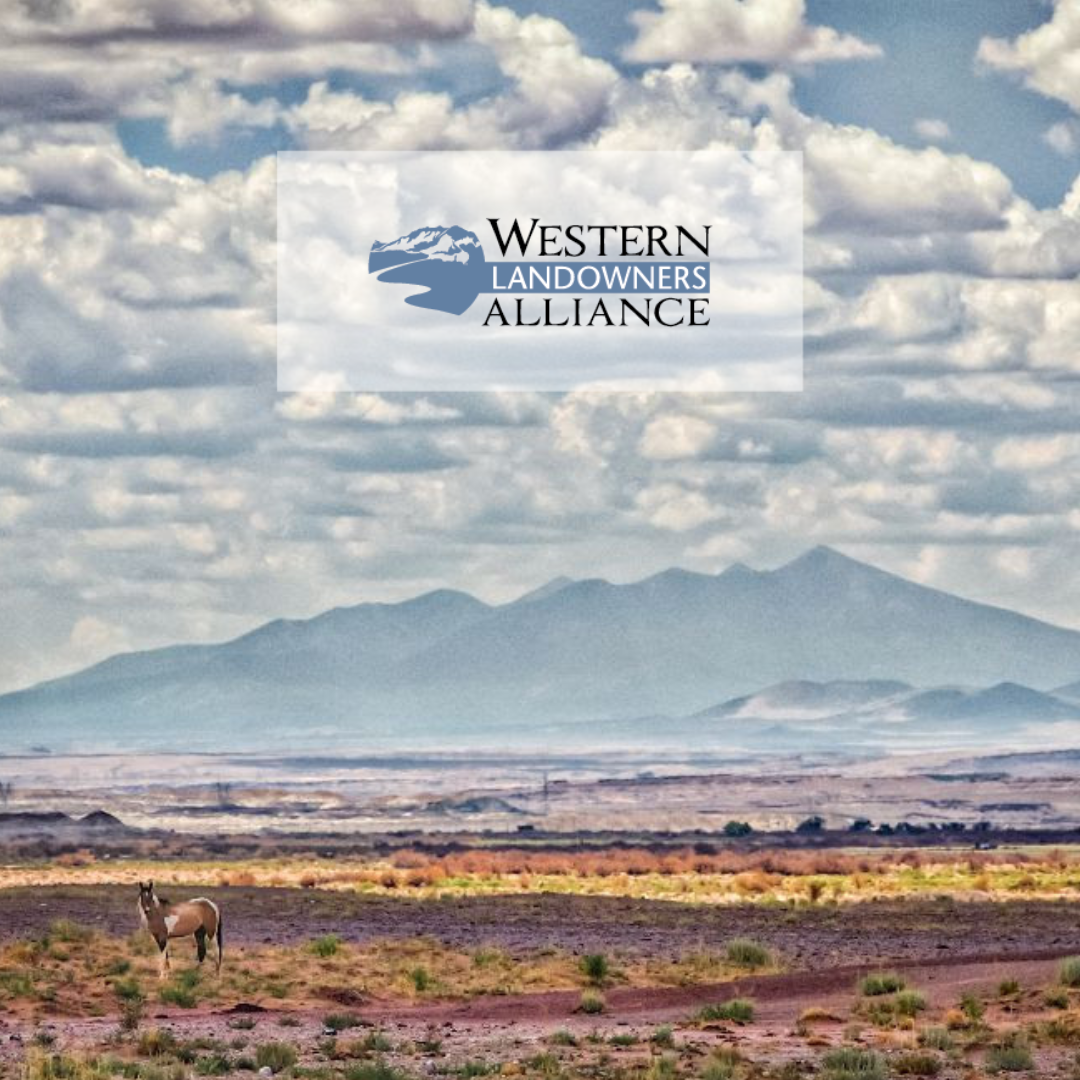Western Digest – August 2018
News and opportunities on working lands, water and wildlife

Women in Ranching gathering at the Diamond Cross Ranch in Birney, MT. Photo by Wendy Millet
Happy August! Articles in this issue range from a cattle business cost study to grassland carbon credits and border wall impacts on wildlife to a new, free rangeland monitoring tool. Enjoy!
As always, this member monthly includes pertinent working lands, water and wildlife news and opportunities from around the West. If you have any information, resources or events that you think would be valuable for this digest, or have questions or comments, please send me an email. I’d love to hear from you.
Hallie Mahowald
Stewardship Services Director
Working Lands Economics
- Cattle Business Cost Study: A new University of California study on the costs and returns of a beef cattle operation helps ranchers and land management agencies plan: UC Division of Agriculture and Natural Resources.
- Payments for Watershed Services: The latest article in WLA’s conservation finance blog series by WRA, Inc. focuses on watershed services programs including how they work, what landowners can expect if they participate and case studies illustrating current programs: Western Landowners Alliance.
- Grassland Carbon Credits: A new market opportunity pays farmers and ranchers to preserve grasslands and lock carbon into the soil. The sale of the first listed grassland carbon credits will allow the Southern Plains Land Trust to restore and preserve two Colorado ranches that sequester 8,000 metric tons of soil carbon per year: Environmental Defense Fund.
- Volatile Cattle Prices: Drought, heat, rain and trade disputes are making cattle markets move several dollars a day: Dakota Farmer.
- Ag Land Easement: A ranch easement in Colusa County, California, through the NRCS Agricultural Land Easement (ALE) program, will allow a family ranch with more than 100 years of history to remain free of development and stay a working ranch: Ag Net West.
- Solar at Feedlots: Colorado State University’s Rural Energy Center finds solar energy at feedlots to be economically feasible: The Fence Post.
Forest & Range
- Matching Cattle to Climate: With the potential for drought, producers have options when it comes to herd selection. Three university livestock and range specialists teamed up to research how cattle producers can match an animal to its environment: Western Farmer-Stockman.
- Grasslands Carbon Storage: A new study finds grasslands can be more effective than forests at storing carbon in places prone to drought and wildfire: Mongabay.
- Women in Ranching: Check out two podcasts highlighting WLA’s new Women in Ranching program on Colorado Ag Today: Aginfo.net (podcast #1 and podcast #2).
- Benefits of Cover Crops: Cover crops have the potential to provide multiple benefits in a cropping system. They prevent erosion, improve soil health, supply nutrients, suppress weeds, improve the availability of soil water and break pest cycles: NRCS.
- Maggie Creek Ranch: Nevada’s Maggie Creek Ranch and its conservation-minded manager, Jon Griggs, works tirelessly for the benefit of the sagebrush ecosystem and the health and viability of the ranch to which he is entrusted: USFWS.
- People of the Sage: The 2018 People of the Sage: Fire & Invasives online communications series is telling the stories of the people combating the twin threats of wildfire and invasive species by showcasing their work in sagebrush country: Partners in the Sage.
- Reed Ranch: Family-owned and operated Reed Ranch in Wyoming’s Thunder Basin builds a legacy beyond livestock: USFWS.
Water
- Irrigation and Precipitation: A national team led by the University of Nebraska is studying potential links between irrigation, cloud formation, and rainfall: Nebraska Farmer.
- Waters of the U.S.: The U.S. District Court in South Carolina ruled against the Trump administration in mid-August for delaying the Obama-era Waters of the United States rule. The decision means the rule is operative again in 26 states where district courts haven’t halted the regulation: Washington Examiner.
- AZ Water Debate: The Arizona Supreme Court gave a proposed housing development a boost yesterday when it determined that the project has adequate long-term water supply. Those who opposed the development said it would dry out one of the Southwest’s only free-flowing rivers: SF Gate.
- Conservation Funding Controversy: A proposal that would let irrigation districts draw funding from a conservation program now reserved for farmers may complicate farm bill talks on Capitol Hill: E&E News.
Wildlife
- Border Wall Impacts: More than 2,700 scientists have signed onto a report warning that an impermeable wall spanning the U.S.-Mexico border would harm wildlife: Washington Post.
- UT Wildlife Bridge: More than 100 wild animals have been killed on a stretch of Interstate 80 near Utah’s Parleys Summit in the past two years. Now the Utah Department of Transportation will build a $5 million wildlife-only bridge — the agency’s first: Salt Lake Tribune.
- Bi-state Sage-grouse Decision: A federal judge has formally thrown out the US Fish and Wildlife Service’s 2015 decision not to list an isolated population of greater sage-grouse along the California-Nevada border for protection under the Endangered Species Act: E&E News.
Policy
- Guide to Farm Bill Conference Process: Interested in what is happening next with the 2018 Farm Bill? National Sustainable Agriculture Coalition (NSAC) has created a Guide to the 2018 Farm Bill Conference Process: NSAC.
- New Forest Service Strategy: The USDA Forest Service announced the concept of an outcome-based investment strategy that responds to the urgent national crisis of the growing challenges of wildfires, invasive species, droughts, degraded watersheds, insects and disease: National Cohesive Wildland Fire Management Strategy.
Tools & Resources
- Rangeland Monitoring Tool: The Rangeland Analysis Platform (RAP) is a free, online tool designed to help landowners and natural resource managers track vegetation through time and plan actions to improve western rangelands: Rangeland Analysis Platform. See information for a webinar on this tool on Sept 25 in the events section below.
- Connectivity Modeling: The Linkage Priority Tool is a new connectivity modeling tool which allows users to prioritize conservation efforts among habitat linkages in a region: Conservation Biology Institute.
- Montana Conservation Menu: Interested in a one-stop shop of current conservation resources and programs for landowners in Montana? If so, check out the Montana Conservation Menu designed by the Soil & Water Conservation Districts of Montana: Intermountain West Joint Venture.
- New Resources for Natural Disaster Impacts: Agricultural producers have new resources available to them to prepare for and recover from impacts of natural disasters on the U.S. Department of Agriculture’s new website, farmers.gov: USDA.
Opportunities
Funding
- USDA “Retaliatory Tarriffs” Help: USDA plans to spend up to $12 billion to help ag producers facing market disruptions due to what it calls “illegal retaliatory tariffs.” Producers will sign up for these programs at their Farm Service Agency office beginning in September: Farm Futures.
- Hurricane and Wildfire Assistance: Agricultural producers affected by hurricanes and wildfires in 2017 now may apply for assistance to help recover and rebuild their farming operations. Signup begins July 16, 2018, and continues through November 16, 2018: USDA.
- Conservation Innovation Grants: NRCS recently announced 22 projects selected for Conservation Innovation Grants at the national level for 2018. Grants total more than $10.6 million. This year’s project competition focused on grazing lands, organic systems and soil health. Note that 21 states are running state CIG competitions. Contact your state NRCS office for information on the state-level competitions.
Employment
- Partnership Coordinator: The Idaho Rangeland Conservation Partnership was created to facilitate collaboration among existing land management entities, private landowners, livestock producers, conservation organizations and other committed partners to foster positive results on rangelands. This effort requires leadership to carry out the group’s vision and they are currently seeking proposals to contract a coordinator.
- Associate Director: RiversEdge West (formerly the Tamarisk Coalition) is hiring an Executive Director to be based in Grand Junction, Colorado. Deadline to apply is September 18, 2018. View the position details here.
- Ranch Apprenticeship: TomKat Ranch is posting a one-year Apprenticeship position for someone interested in gaining experience in regenerative agriculture and working with livestock and science to improve the productivity and resilience of the land. Learn more here.
Events & Webinars
- September 6-7: “Reading the Landscape: Grazing for Production and Resilience” workshop with Quivira Coalition at the San Juan Ranch, Colorado. More information here.
- September 7-8: HMI’s Sunfire Ranch: Whole Farm Land Management Workshop “Achieving your best possible outcomes with adaptive management” near Carbondale, Colorado. Note: workshop is part of series devliered in two multi-day sessions continued on October 5-7. Register here.
- September 8: An Evening with Nathan Sayre hosted by the Altar Valley Conservation Alliance at the Mountain Oyster Club in Tucson, Arizona. Learn more and purchase tickets here.
- September 11-12: “Rising to the Challenge” #forestproud gathering in Atlanta, Georgia. Check out the event page for full details and register here.
- September 18-20: Colorado Wildland Fire Conference 2018 in Crested Butte, Colorado. Registration is $295. Register here.
- September 24: Regenerative Ranching and Farming Workshop with Ray Archuleta, Gabe Brown and Alejandro Carillo in Raton, New Mexico. More information here or call or text Kim Barmann at 505-217-6657.
- September 25: WEBINAR at 10 AM MT: “Rangeland Analysis Platform: Introducing a free, online tool to help manage and monitor western rangelands” presented by the USDA. More information here.
- September 24-26: WLA’s “Land & Livelihoods” Conference in Billings, Montana. Check out the conference website for details and registration.
- September 24-26: Women in Agribusiness Summit in Denver, Colorado. More information here.
- October 2-4: Private Lands Partners Day hosted by Partners for Conservation in Springfield, Missouri.
- October 16-17: Restoring the West Conference “Multiple use and sustained yield of resources on public lands: Is it still possible?” at Utah State University in Logan, Utah.
- October 19-20: Noon Ranch Arroyo Restoration Workshop hosted by Altar Valley Conservation Alliance near Tucson, Arizona. Learn more and register here.
- October 30 – November 2: 2018 Regenerate Conference hosted by Quivira Coalition, Holistic Management International, and American Grassfed Association in Albuquerque, New Mexico.
- December 10-14: 15th International Wildland Fire Safety Summit and 5th Human Dimensions of Wildland Fire Conference in Asheville, North Carolina.
- January 28-30, 2019: Rural Voices for Conservation Coalition (RVCC) Annual Meeting in Santa Fe, New Mexico including a shared day with WLA focused on collaboration to increase the health and resilience of public and private lands and rural communities.
- April 29 – May 3, 2019: 6th International Fire Behavior and Fuels Conference in Albuquerque, New Mexico. The conference theme is “Fuels of Today–Fire Behavior of Tomorrow,” and will be held simultaneously in Albuquerque, Sydney (Australia) and Marseille (France).
Membership
The Western Landowners Alliance advances policies and practices that sustain working lands, connected landscapes and native species.
Not yet a member? We invite you to Join Us.
Join WLA to stay up to date on the most important news and policy for land stewards.
Become a member for free today and we will send you the news and policy developments critical to the economic and ecological health of working lands.
WLA works on behalf of landowners and practitioners throughout the West. We will never share your contact information with anyone.

